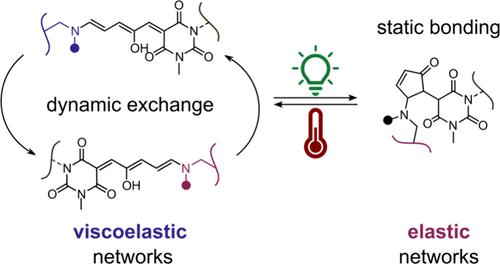Donor–Acceptor Stenhouse Adducts as Intrinsically Photoswitchable Dynamic Covalent Bonds
IF 15.6
1区 化学
Q1 CHEMISTRY, MULTIDISCIPLINARY
引用次数: 0
Abstract
Combining dynamic covalent bonds with photoswitches allows the kinetics and thermodynamics of exchange to be controlled with light. However, this two-component strategy introduces synthetic and compatibility challenges. Here, we present a single-component strategy using donor–acceptor Stenhouse adducts (DASAs) as both the photoswitch and the dynamic covalent bond. DASAs isomerize from “open” to “closed” forms with light and heat, respectively. We discovered that open DASA isomers undergo dynamic covalent exchange of their amine donor via two pathways, reversible dissociation and conjugate transamination. Exchange can then be arrested upon irradiation to form the closed DASA isomer, offering a handle to gate dynamic behavior. Consequently, incorporating DASAs as cross-linkers in PDMS-based networks yields covalent adaptable networks (CANs) with viscoelastic behavior that can be tuned by light. We also identify degradation pathways that limit the reversibility of this system under extended heating. Overall, DASA exchange represents a synthetically accessible platform for photocontrolled soft materials. More broadly, this work introduces DASAs as a new class of intrinsically photoswitchable dynamic covalent bonds and lays the foundation for the discovery of other stimuli-gated dynamic bonds that combine reactivity and responsiveness in a single molecular unit.

施-受体斯坦豪斯加合物作为内在光可切换的动态共价键
将动态共价键与光开关结合,可以用光控制交换的动力学和热力学。然而,这种双组件策略引入了合成和兼容性方面的挑战。在这里,我们提出了一种单组分策略,使用施腾豪斯加合物(DASAs)作为光开关和动态共价键。dasa分别在光和热作用下从“开放”形态异构为“封闭”形态。我们发现开放的DASA异构体通过可逆解离和共轭转胺两种途径进行胺供体的动态共价交换。然后,交换可以在照射时被阻止,形成封闭的DASA异构体,提供一个控制动态行为的处理。因此,将dasa作为交联剂结合到基于pdms的网络中,可以产生具有粘弹性行为的共价自适应网络(can),该网络可以通过光进行调节。我们还确定了在长时间加热下限制该系统可逆性的降解途径。总的来说,DASA交换代表了光控软材料的综合可访问平台。更广泛地说,这项工作将DASAs作为一类新的内在光开关动态共价键引入,并为发现其他在单个分子单元中结合反应性和响应性的受激动态键奠定了基础。
本文章由计算机程序翻译,如有差异,请以英文原文为准。
求助全文
约1分钟内获得全文
求助全文
来源期刊
CiteScore
24.40
自引率
6.00%
发文量
2398
审稿时长
1.6 months
期刊介绍:
The flagship journal of the American Chemical Society, known as the Journal of the American Chemical Society (JACS), has been a prestigious publication since its establishment in 1879. It holds a preeminent position in the field of chemistry and related interdisciplinary sciences. JACS is committed to disseminating cutting-edge research papers, covering a wide range of topics, and encompasses approximately 19,000 pages of Articles, Communications, and Perspectives annually. With a weekly publication frequency, JACS plays a vital role in advancing the field of chemistry by providing essential research.

 求助内容:
求助内容: 应助结果提醒方式:
应助结果提醒方式:


